High mineral prices drive rainforest destruction
High mineral prices drive rainforest destruction
Rhett A. Butler, mongabay.com
August 13, 2008
|
|
The surging price of minerals is contributing to degradation and destruction of rainforests worldwide, warns a researcher writing in the current issue of New Scientist.
William F. Laurance, a biologist at the Smithsonian Tropical Research Institute in Panama, says the high price of gold, coal, and other minerals is driving an influx of miners — legal and illegal — into tropical countries, where there are extensive mineral deposits but environmental protections are often a low priority. Pollution, deforestation, overhunting, and invasion of indigenous territories and protected areas can result.
“I recently witnessed gangs of illegal gold miners in the rainforests of Suriname, in north-eastern Amazonia,” Laurance writes. “The miners were blasting at river banks with pressure hoses, devastating the ecosystem there. Once-pristine streams had become malaria-infested pools choked with sediment, the water stained bright red or yellow, and contaminated with mercury used by miners to amalgamate gold particles.”
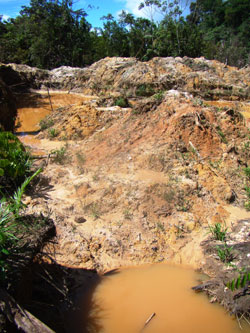 Gold mining in Suriname. Photo by William F. Laurance |
“Because of such pollution, indigenous and other rural communities in many gold-bearing regions of Amazonia often cannot find clean water to drink. Fisheries are being decimated too; mercury accumulates as it moves up the food chain, reaching dangerous concentrations in the larger fish that local residents rely on for protein.”
Laurance notes that developing countries are also having problems controlling legal operations. He cites a surge in coal mining in Indonesia as an example. Multinational mining firms are lining up to exploit rich coal deposits in Kalimantan (Indonesian Borneo) but environmental considerations are often an afterthought. Meanwhile Malaysia is preparing to embark on a dramatic dam-building spree in the Bornean state of Sarawak to increase electricity-generating capacity to attract mineral smelters and refiners. The plan is sanctioned by the state and federal governments despite opposition from environmentalists and a court-ruling against the scheme.
Reducing mining damage
Laurance says that detrimental mining impacts can be reduced by enforcing existing laws as well as improving mining management. Restricting road-building would further mitigate some of the collateral damage from mining activities.
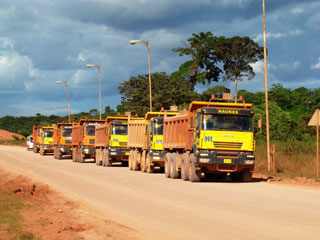 Mining trucks lining up in Suriname 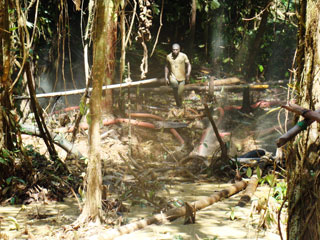 Gold mining in Suriname. Photos by William F. Laurance |
Laurance also argues that multinational mining companies should pay a larger share of the cost of controlling illegal mining in developing countries.
“These firms are attracted to developing countries by low taxes and labor costs, modest mineral royalties and relatively lax environmental laws. They should shoulder a larger share of the burden,” he writes.
Finally, Laurance says that consumers in rich countries need to own up to their role in promoting environmentally-destructive activities in tropical forests.
“The world’s major mining corporations are headquartered in wealthy nations, and we should demand that they meet higher standards. We should support nongovernmental groups that are trying to expose bad environmental and social practices. And we should lobby those who invest in international mining to use great caution, for they could be inadvertently profiting from environmental destruction,” he concludes.
William Laurance (2008). The real cost of minerals. NewScientist | 16 August 2008
Related articles
Scientists call for mining ban, new protected areas in Suriname
(6/20/2008) In a resolution set forth at their annual meeting in Paramaribo, Suriname, the largest group of tropical biologists called upon the Surinamese government to evict informal gold miners from three ecologically important areas in the South American country. Miners have been blamed for a number of environmental problems including over-hunting of wildlife, deforestation and destruction of riparian habitats, erosion, and mercury pollution in waterways.
Geology, climate links make Guiana Shield region particularly sensitive to change
(6/14/2008) Soil and climate patterns in the Guiana Shield make the region particularly sensitive to environmental change, said a scientist speaking at a biology conference in Paramaribo, Suriname.
Venezuela bans gold-mining in forest reserve, will not issue new open-pit permits
(5/21/2008) Venezuela banned gold mining in its Imataca Forest Reserve and said it will not issue new permits for open-pit mines anywhere in the country, according to Reuters.
Malaysia rejects coal project in Borneo rainforest
(4/14/2008) Malaysia has rejected a $408 million coal-fired power plant near a protected rainforest area in Sabah, on the island of Borneo.
France blocks controversial rainforest gold mine in French Guiana
(2/6/2008) Environmentalists declared victory after the French government blocked approval of a controversial gold mine bordering the Kaw wetland, an ecologically rich site in French Guiana. The decision was handed down last week following an environmental assessment by the Ministry of Ecology and Sustainable Development based on work by local scientists.
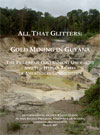 |
Gold mining in Guyana damages environment, threatens Amerindians
(3/6/2007) Informal gold mining is causing environmental harm and human rights abuses in Guyana says a new report from the International Human Rights Clinic (IHRC) of Harvard Law School’s Human Rights Program. Wildcat gold mining has been a serious problem in the Guiana shield countries of Brazil, Venezuela, Guyana, Suriname and French Guiana. Rising gold prices in recent years have only worsened the problem, as illegal miners have flooded the region clearing forest, polluting rivers, and making threats against indigenous people.
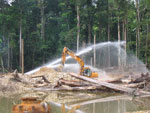 |
Europe’s largest tropical rainforest invaded by gold miners
(12/19/2006) As Europe frets over climate change and deforestation, threats to “Europe’s largest tropical rainforest” are mounting, according to reports from French Guiana. While French Guiana is best known for its infamous Devil’s Island penal colony and as the main launch site for the European Space Agency, which is responsible for more than 50% of the state’s economy activity, most of the territory is covered with lowland tropical rainforest. French Guiana’s forests are biologically rich with some 1,064 known species of amphibians, birds, mammals and reptiles, and 5,625 species of vascular plants according to figures from the World conservation Monitoring Center.
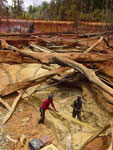 |
Mining in Venezuelan Amazon threatens biodiversity, indigenous people
(11/9/2006) Troubles are mounting in one of Earth’s most beautiful landscapes. Deep in the Venezuelan Amazon, among ancient forested tabletop mountains known as tepuis, crystalline rivers, and breathtaking waterfalls, illegal gold miners are threatening one of world’s largest remaining blocks of wilderness, one that is home to indigenous people and strikingly high levels of biological diversity. As the situation worsens — a series of attacks have counted both miners and indigenous people as victims — a leading scientific organization has called for the Venezuelan government to take action.